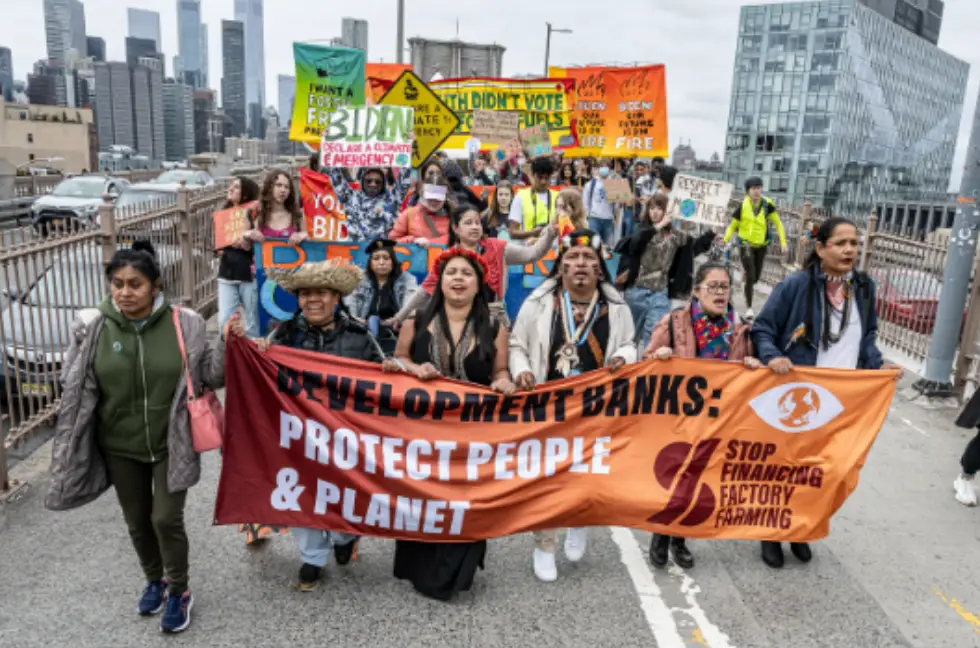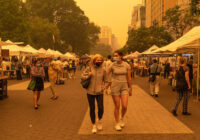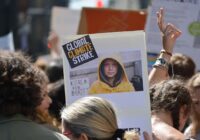On April 19, a rainbow deluge of over a thousand protesters marched across the Brooklyn Bridge, singing “The people are gonna rise like the water.” They carried flame-colored banners, omens of our scorching future. A mother in a helmet and leather jacket pushed her two young sons in a yellow wheelbarrow. The younger boy was no more than four years old.
Fridays for Future (FFF), an international youth-led climate movement, organized a series of strikes across the country on April 19. They were in a fighting mood. A 17-year-old student who attends the Manhattan Center for Science and Mathematics told me that, if US President Joe Biden “wants us to show up to vote for him in the polls, he needs to take action.” A few paces away from her, another girl held a sign in the air like Neptune with his trident that said, “I didn’t vote for fires and floods.”
Coordinated demonstrations across the country
Four days earlier, I had spoken with Keanu Arpels-Josiah, a 19-year-old student at Little Red School House and Elisabeth Irwin High School. Keanu was one of the lead organizers of the march. He had told me that the strike was “part of a broader national escalation of 200 actions around the country.”
Keanu described the process of organizing people to show up to strike. “We have a network of different people who are school ambassadors, and a lot of it is just texting friends we know at other schools and seeing if they know someone who’d be interested in getting a group to go.” He told me that the central purpose of the marches and the strikes was to get Biden to declare a climate emergency.
Keanu told me, “This is a president who ran for president saying, ‘I will end fossil fuels.’ What we’ve seen him do is quite the opposite.”
Four days later, the marchers gathered in Foley Square in downtown New York City. They chanted, “Keep it in the ground, just keep it in the ground.” They were referring to fossil fuels, particularly oil.
Fighting for nature and for justice
Fittingly, Foley Square sits atop the grave of Collect Pond, a natural spring that the city smothered with pavement in the 1920s. Further beneath where Collect Pond used to gurgle lies a nearly 300-year-old African burial ground. Thousands of men, women and children rest beneath Foley Square.
The FFF protesters marched across the Brooklyn Bridge, stepping further and further into the cage of cables that holds the structure up. The bridge is an industrial caricature of a tree-canopy. When its construction was completed in 1883, the bridge became the longest suspension bridge ever built and was regarded as a miracle of modern engineering. Now, it has become a reminder of the fossil-fuel-guzzling industry that underpins the modern global economy.
“Love your mother,” one teenage girl’s sign read. She had drawn a water-colored earth on this square cardboard sign. She was alluding to Mother Earth, as Earth Day was soon to follow on April 22.
“When the climate is under attack, what do we do?” shouted one girl into a megaphone. “Stand up, fight back!” the crowd cried back with fervor. “When the air we breathe is under attack, what do we do?” “Stand up, fight back!” The slogans went beyond the environment. “When the Palestinians are under attack, what do we do?” “Stand up, fight back!”
“Climate justice is intersectional: Free Gaza,” said another sign in thick sharpie. Another woman held up a Palestinian flag above her like a torch. She was wearing an indigo backpack stamped with the words “extinction rebellion” below a butterfly with wings like tapestries. To her right, a teenage boy clutched a rainbow sign with the words “queer climate justice.”
In front of me strode a short indigenous woman, wearing a straw hat and robed like a preacher in yellow and blue monarch butterfly wings. Her name was Gabina Santamaria. She was 50 years old and lived in Staten Island. “I hope our president hears us and does something for climate change,” she told me, “especially because I have kids.” “My kids’ futures…” she pleads. She wrapped me in her butterfly wings.
“I hear the voice of my great-granddaughter singing, ‘Climate Justice Now,’” the congregation of protestors chorused.I pulled aside the 17-year-old leading the song, and asked her why she was there. “I am worried. I’m not just worried for my children’s futures, I’m worried for my future. My future is getting destroyed by Biden’s actions.” I notice another sign, held in front of another young girl like a desperate soldier. “What future are you studying for?”
Indigenous leadership and a child’s concern
I observed some motifs in the outfits of the youth. Wide-leg jeans, colored sunglasses, copious amounts of peace signs — a style reminiscent of the student protests of the 1960s. The march stopped at Borough Hall, a Greek Revival edifice completed in 1848. With a backtrack of Bob Dylan’s “The Times They Are A-Changin’,” the demonstrators assembled on and in front of the Tuckahoe marble stairs.
Borough Hall borders Columbus Park, anchored by a statue of the abolitionist orator Henry Ward Beecher and named for Christopher Columbus, trailblazer of the Americas and exploiter of indigenous lands. The indigenous women that led the line are battling the same displacement begun centuries ago by Columbus.
One by one, numerous speakers stepped up to the podium and delivered speeches. Lena Goings, a 16-year-old organizer with FFF, instructed the crowd to remember that the climate movement was started by indigenous leadership. Shirley Krenak, an indigenous activist from Brazil, attending with the Black and Indigenous Liberation Movement, directed everyone to repeat after her. “When we speak the same language Mother Earth listens,” she proclaimed.
She declared, “Today, you are my people.” We chanted in her tongue, bending down and up, down and up, and crooning soft hymns like mothers. Then she told us to scream. A guttural scream, like a war cry, rose out of the crowd as the people’s anger, betrayal and hope unified into one roar for change.
As the rally subsided, Joni Mitchell’s “Paved Paradise” bid us farewell: “They paved paradise, put up a parking lot.” A little boy, tiny in an orange puffer coat, stood next to his mother. They were part of Climate Families NYC. The six-year-old Jasper told me that he is scared for the planet. “What if climate companies don’t do anything about it?” he asked me in a quavering voice. “What if they don’t stop?”
The views expressed in this article are the author’s own and do not necessarily reflect Fair Observer’s editorial policy.
Support Fair Observer
We rely on your support for our independence, diversity and quality.
For more than 10 years, Fair Observer has been free, fair and independent. No billionaire owns us, no advertisers control us. We are a reader-supported nonprofit. Unlike many other publications, we keep our content free for readers regardless of where they live or whether they can afford to pay. We have no paywalls and no ads.
In the post-truth era of fake news, echo chambers and filter bubbles, we publish a plurality of perspectives from around the world. Anyone can publish with us, but everyone goes through a rigorous editorial process. So, you get fact-checked, well-reasoned content instead of noise.
We publish 2,500+ voices from 90+ countries. We also conduct education and training programs
on subjects ranging from digital media and journalism to writing and critical thinking. This
doesn’t come cheap. Servers, editors, trainers and web developers cost
money.
Please consider supporting us on a regular basis as a recurring donor or a
sustaining member.
Will you support FO’s journalism?
We rely on your support for our independence, diversity and quality.







Comment